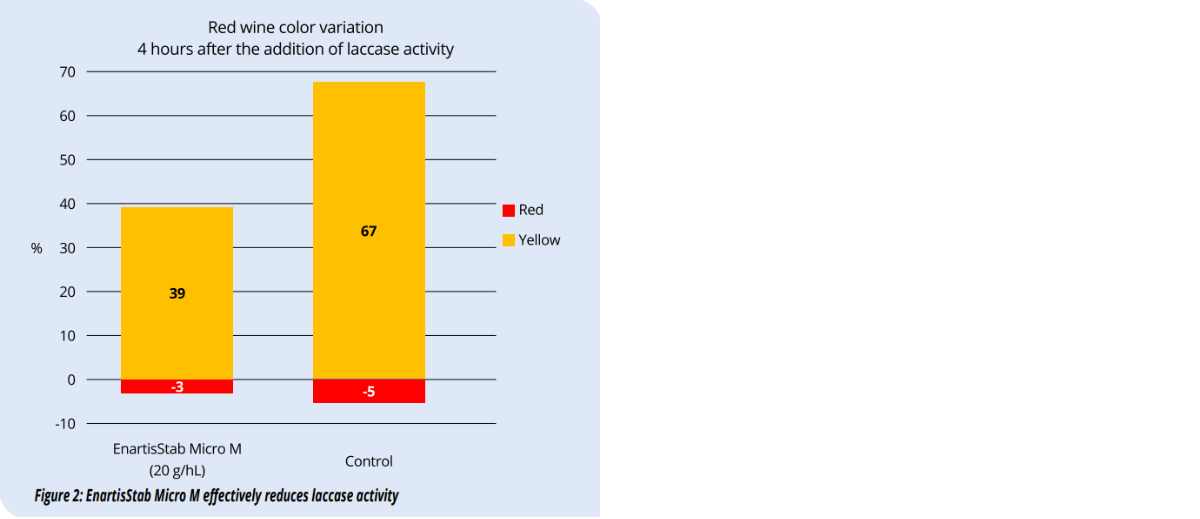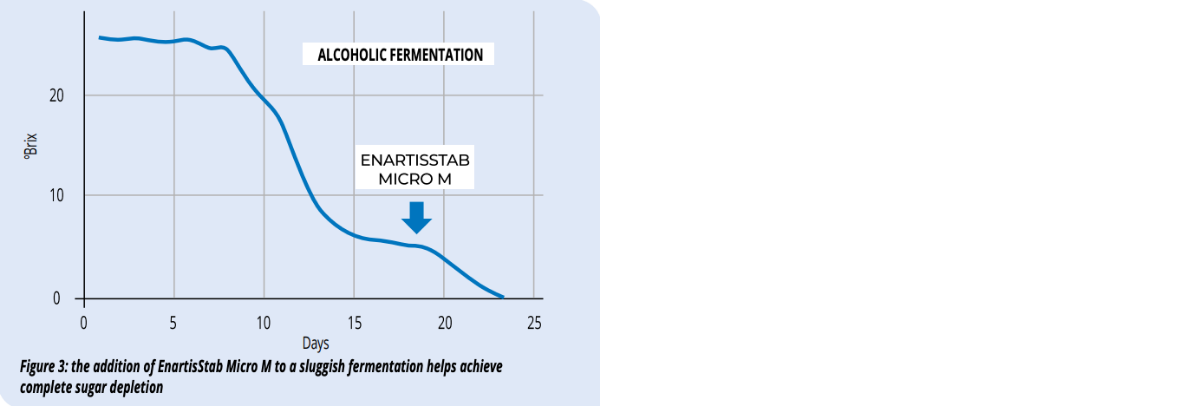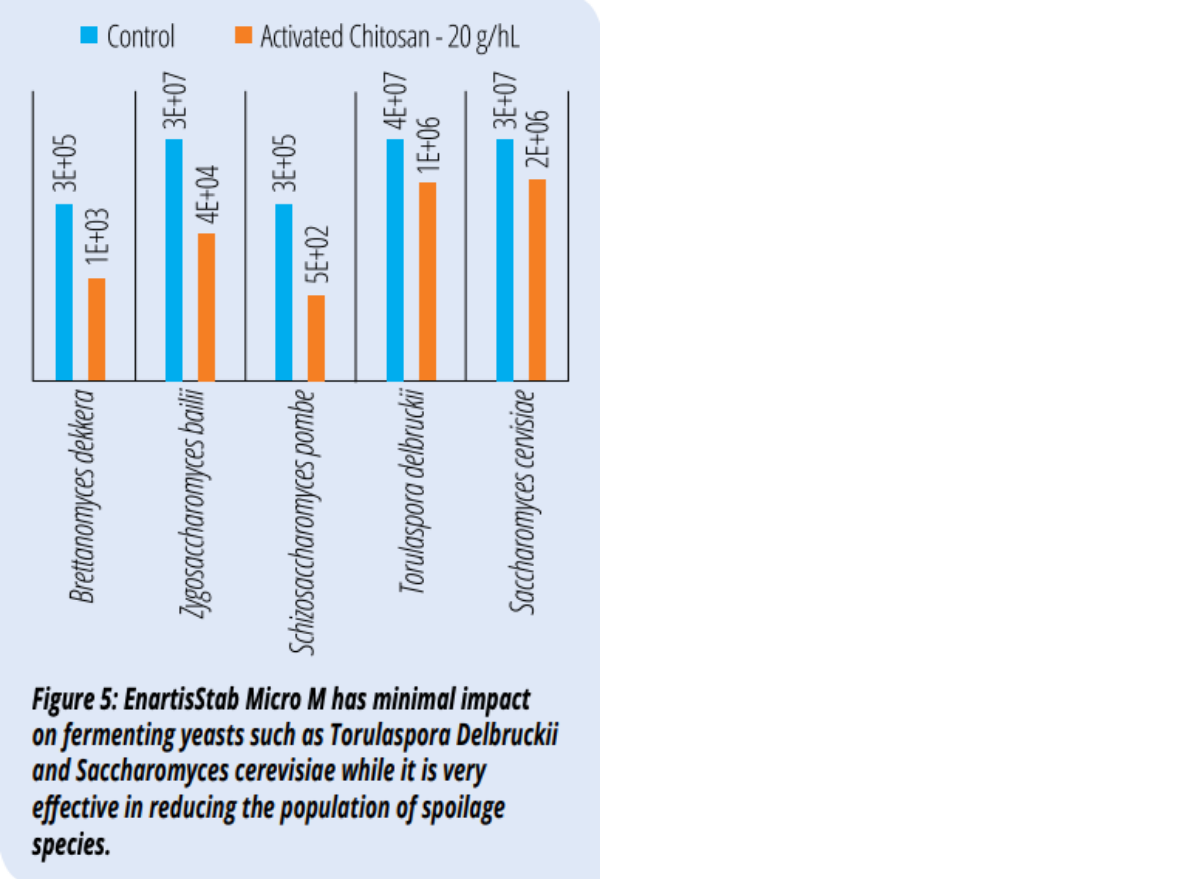Enartis News – Protective microbial and antioxidant control techniques
Microbial control is one of the most critical factors in elaborating quality wines. With the potential labor shortages, quality control measures like sorting fruit and utilizing bio-protective strategies will be less feasible considering the time and financial limitations the wine industry is facing. Additive microbial control techniques will play a central role in preventing and sustaining wine quality.
SULFUR DIOXIDE AND ASCORBIC ACID
Sulfur dioxide has long been the antimicrobial and antioxidant of choice for winemakers and is one of the most important preservatives in winemaking. Potassium metabisulfite (KMBS) is the most widely used approved form of SO2.
It should be noted that not all formulations of KMBS are the same, especially when considering the ease of application. Some forms of KMBS can easily clump and agglomerate, making weighing and handling difficult in the cellar. It is important to consider these factors to help increase the ease of application of various enological additives while considering workers safety. Ascorbic acid is another antioxidant that is used in conjuction with SO2. These two antioxidants complement each other in that SO2 has a stable semi-continuous effect in the presence of oxygen, while ascorbic acid antioxidant activity is instant, protecting a wine from detrimental, abrupt aerations. Blends of ascorbic acid, KMBS and tannin are especially useful transporting grapes and remediating compromised fruit infected with Botrytis cinerea.

ACTIVATED CHITOSAN
Chitosan is an allergen free and vegan friendly natural polysaccharide produced from Aspergillus niger displaying various bioactive and antimicrobial activities depending on its modification during production.
For the harvest period, Enartis offers EnartisStab Micro M, an allergen free and vegan friendly bioregulator containing activated chitosan and yeast hulls rich in chitin-glucan.
EnartisStab Micro M was specifically developed for the treatment of turbid musts and wines and therefore, it is especially recommended for the early stages of wine production, from harvest to the end of MLF.
Its powerful antimicrobial activity depends on the pre-activation process used by Enartis during production. In fact, chitosan antimicrobial activity is attributed to its positively-charged surface that interferes with negatively-charged residues on the microorganism’s cell membrane surface and thereby alters its membrane permeability resulting in cell death. This modification step increases the reactivity and polymer surface area allowing for lower dosages and superior antimicrobial activity. That is why EnartisStab Micro M can control the development of numerous contaminants in different stages of vinification.
REASONS FOR USING ENARTISSTAB MICRO M IN HARVEST
CONTROL JUICE CONTAMINANTS
On grapes, in the juice pan, in must and during cold soak EnartisStab Micro M reduces wild yeasts (Brettanomyces, Schizosaccharomyces) and bacteria (Acetobacter, Oenococcus, Pediococcus, Lactobacillus), population thus limiting volatile acidity and other off-flavor production. EnartisStab Micro M is able to assure an adequate antimicrobial protection also in high pH juice where SO2 has a very little activity.

HELP THE DOMINANCE OF THE SELECTED YEAST
EnartisStab Micro M reduces wild microorganisms’ competition and promotes the dominance of the inoculated yeast, thus improving fermentation kinetic and cleanliness.
LIMIT LACCASE ACTIVITY
In case of botrytised grapes, EnartisStab Micro M limits laccase activity. Mechanisim is not known yet but there are various hypotesis: removal/inactivation of laccase (negatively charged) by direct interaction with chitosan (positively charged); removal of copper (pro oxidant and pro-oxidase metal); removal of oxidation substrate (catechins). Whatever the mechanism, the fact is that the use of EnartisStab Micro M reduces browning and preserves more aromatics and color intensity.

CONTROL CONTAMINANTS IN CASE OF SLUGGISH AND STUCK FERMENTATION
EnartisStab Micro M is used to stop the growth of acetic and malolactic bacteria which otherwise can metabolize residual sugars, increase acetic acid content and inhibit fermentation restart
.
DELAY OR PREVENT THE MALOLACTIC FERMENTATION
At the end of alcoholic fermentation EnartisStab Micro M can be used as an alternative to lysozyme to delay or avoid MLF with the additional advantages of being an allergen-free compound, vegan friendly, no impact on protein stability and no significant impact on color.

PREVENT THE FORMATION OF H2 S
EnartisStab Micro M can be used to prevent the formation of H2 S and preserve a bigger quantity of free SO2 . The fermenting yeast remain alive for at least 10-15 days after the completion of alcoholic fermentation. An addition of SO2 done in this time period will activate yeast enzymatic pathways that will lead to the formation of H2 S and SO2 binders, mainly acetaldehyde. These two mechanisms help yeast turn SO2 into less harmful compounds but create two enological problems: appearance of reduction and increase of bound SO2 content. The use of EnartisStab Micro M allows to postpone sulfur addition by at least two weeks whilst ensuring the wine is protected from spoilage microorganisms.
PRESERVE A BIGGER QUANTITY OF SO2
EnartisStab Micro M can be used to preserve a bigger quantity of free SO2 . It is known that lactic acid bacteria have the ability to degrade the acetaldehyde that is produced by fermenting yeast. Degradation takes place mainly in the 2-3 weeks after malic acid depletion. This means that an early addition of SO2 after malic acid depletion, can turn into the bound form by up to 80%. To fully take advantage of malolactic fermentation’s contribution towards decreasing the total SO2 level, delaying SO2 addition by 7-10 days after malolactic fermentation completion is advised.
EnartisStab Micro M allows to postpone sulfur addition by at least 2 weeks whilst controlling the growth of spoilage microorganisms, mainly Brettanomyces.
PROMOTE QUALITY DURING NATIVE FERMENTATION
Native fermentation can be used to produce unique wines thanks to the contribution of wild yeast strains naturally present on the grapes or in the cellar; nevertheless, this practice is not without risk. The dominance of yeast with poor oenological attributes can lead to stuck fermentation or production of faulty wines. Taking advantage of Saccharomyces cerevisiae and Torulaspora’s low sensitivity to chitosan, EnartisStab Micro M can be added to the must to help the dominance of the best fermenting yeast over non-Saccharomyces yeast and bacteria, and increase the chances of a clean, regular and complete fermentation.

REDUCE OR ELIMINATE THE USE OF SO2
EnartisStab Micro M can partially or totally replace sulfur dioxide addition. In fact, besides its antimicrobial activity, chitosan performs its own antioxidant action. It has the capability of reducing browning, pinking, loss of aromatics and preventing the increase of acetaldehyde, thanks to its capability of chelating copper and iron that activate the oxidative process.